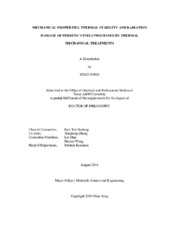| dc.contributor.advisor | Hartwig, Karl T | |
| dc.contributor.advisor | Zhang, Xinghang | |
| dc.creator | Song, Miao | |
| dc.date.accessioned | 2015-02-05T17:28:14Z | |
| dc.date.available | 2016-08-01T05:30:10Z | |
| dc.date.created | 2014-08 | |
| dc.date.issued | 2014-08-04 | |
| dc.date.submitted | August 2014 | |
| dc.identifier.uri | https://hdl.handle.net/1969.1/153503 | |
| dc.description.abstract | The dramatically increasing demand for energy stimulates scientists all over the world to consider the possible ways to meet future energy needs. The application of atomic energy has been demonstrated to be a reliable, economic, and environmental friendly choice by the reactors operating today for half century. Lessons have been learned during the operation of generation I-III reactors. To avoid an unanticipated failure, high performance structural materials still represent a crucial component for extending the operation life of current reactors and the design of generation IV nuclear reactors and future fusion reactors. Due to their superior radiation tolerance, ferrite steels are currently the primary candidate under examination for generation IV or future fusion reactors.
Whereas considerable data have been published on modification of the chemical composition of ferrite steels and evaluation of their overall performance, few attempts have been tried to process the existing ferrite steels by plastic deformation and evaluate the performance and properties improvements. The deformation technique introduced here is equal channel angular extrusion (ECAE). During ECAE, severe shear strain (on the order of several hundred percent) is introduced into a material by extrusion through a channel of constant cross section that contains an abrupt angle.
The work presented in this dissertation is an attempt to apply ECAE to reactor steels of interest-namely T91 and 12Cr ODS. T91 (modified 9Cr-1Mo steel) is widely used and a commercialized material. 12Cr ODS is an oxide dispersion strengthened ferrite steel developed based on the reduce activation concept and targeted for cladding at elevated temperature. The pros and cons for such an approach were evaluated based on the influence of such a plastic deformation on mechanical performance, thermal stability and radiation damage or tolerance.
In general, ECAE processed materials show improved strength and radiation tolerance. However, thermostability and ductility are sacrificed. The latter is not a potential problem because during service at elevated temperatures, the ECAE processed materials can regain ductility within a short period. Attention should be paid to the degeneration of thermostability after ECAE deformation. | en |
| dc.format.mimetype | application/pdf | |
| dc.language.iso | en | |
| dc.subject | T91 | en |
| dc.subject | ECAE | en |
| dc.subject | microstructure | en |
| dc.subject | radiation | en |
| dc.subject | ultrafine grain | en |
| dc.title | Mechanical Properties, Thermal Stability and Radiation Damage of Ferritic Steels Processed by Thermal Mechanical Treatments | en |
| dc.type | Thesis | en |
| thesis.degree.department | Materials Science and Engineering | en |
| thesis.degree.discipline | Materials Science and Engineering | en |
| thesis.degree.grantor | Texas A & M University | en |
| thesis.degree.name | Doctor of Philosophy | en |
| thesis.degree.level | Doctoral | en |
| dc.contributor.committeeMember | Shao, Lin | |
| dc.contributor.committeeMember | Wang, Haiyan | |
| dc.type.material | text | en |
| dc.date.updated | 2015-02-05T17:28:14Z | |
| local.embargo.terms | 2016-08-01 | |
| local.etdauthor.orcid | 0000-0002-4699-7462 | |


